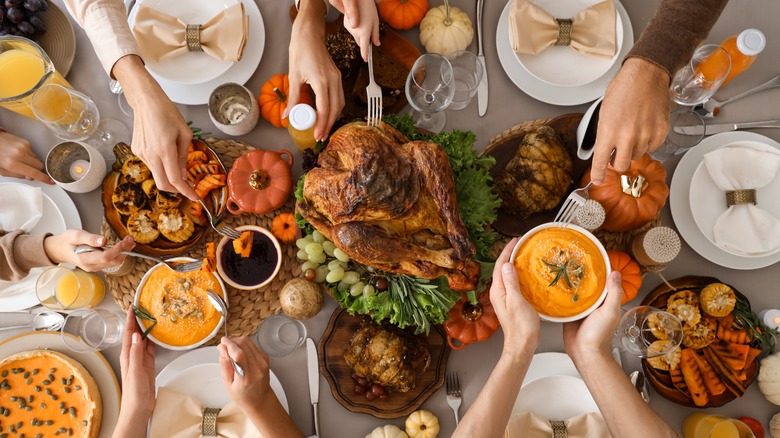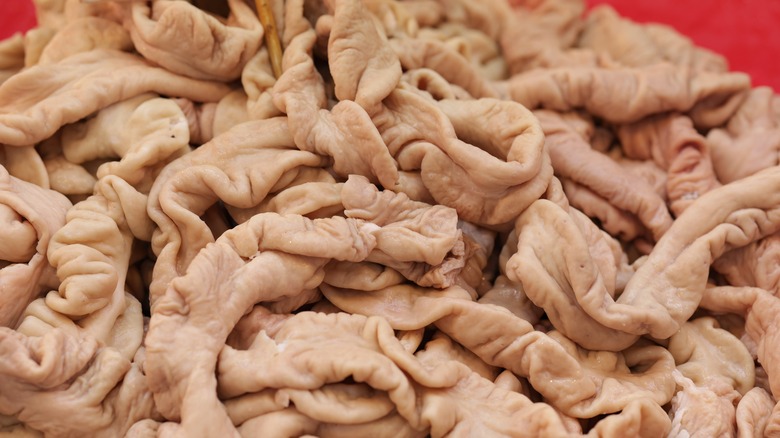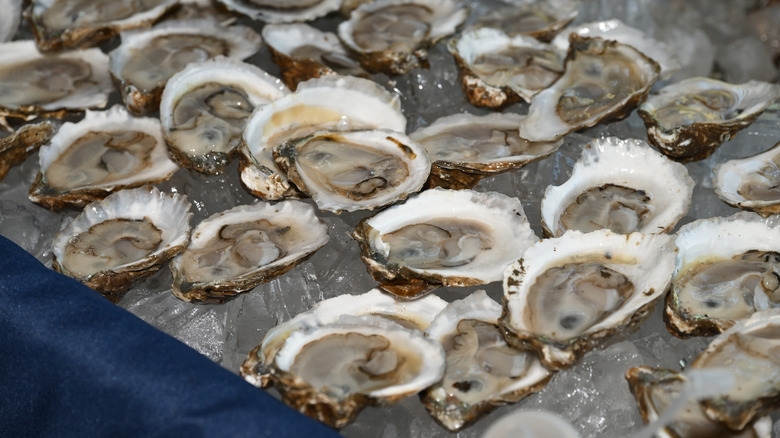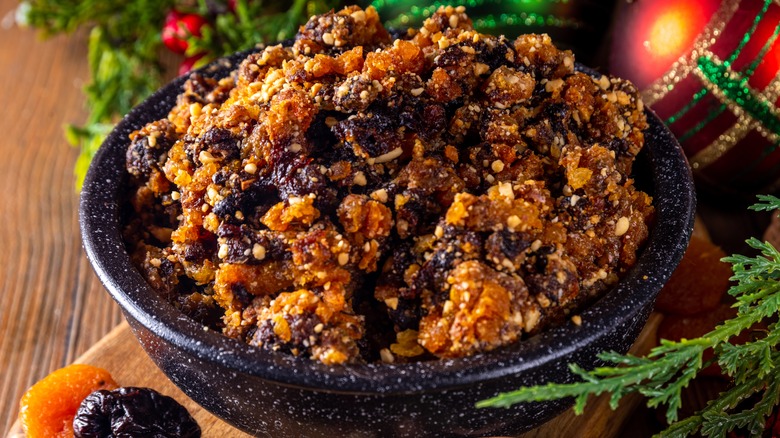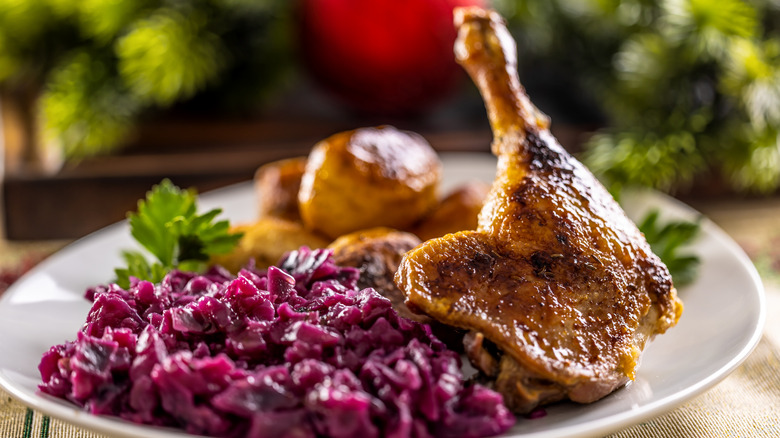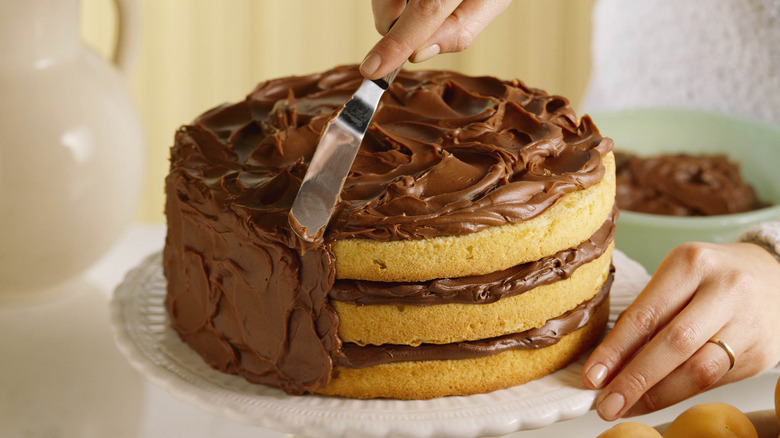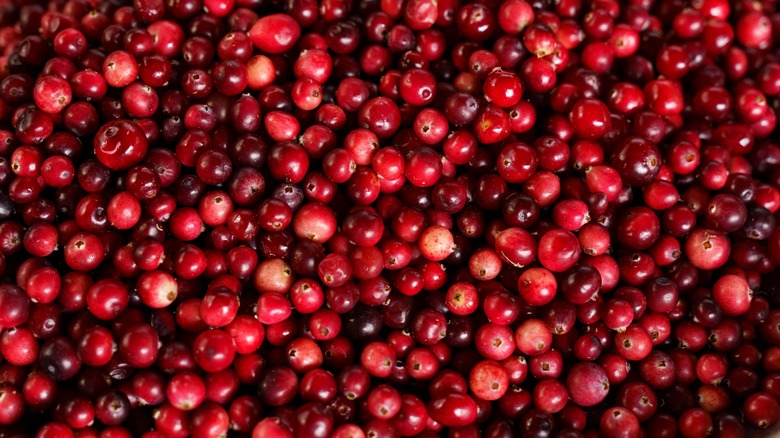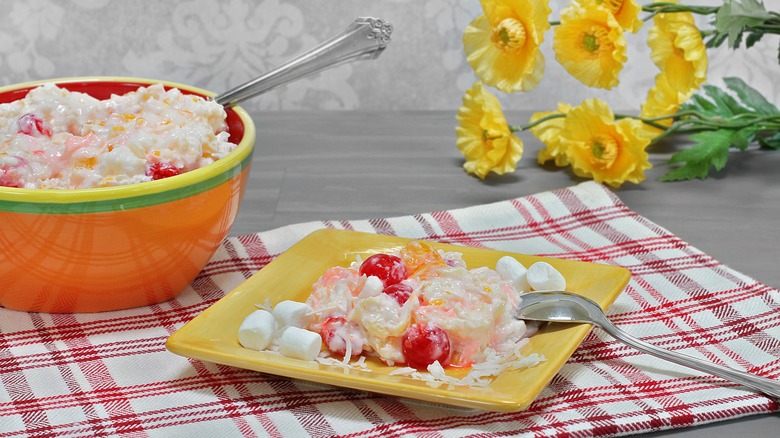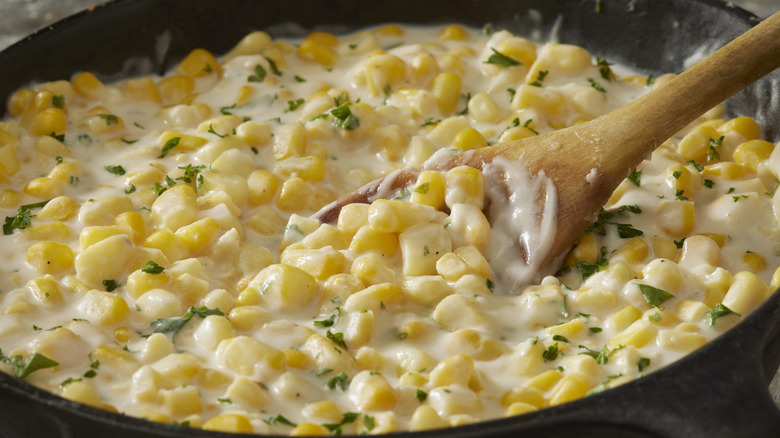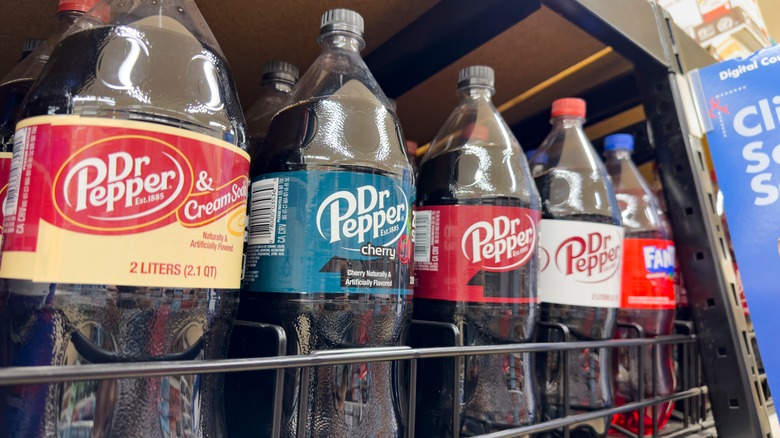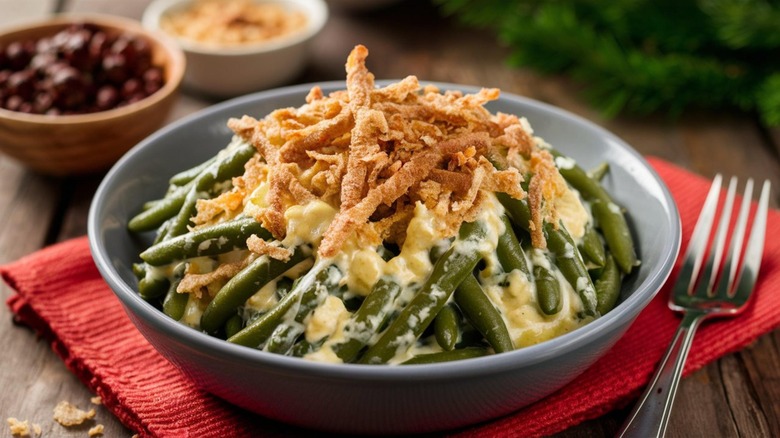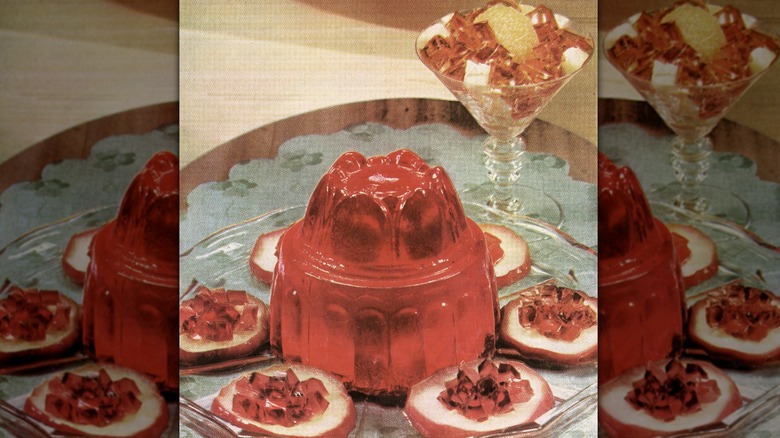Once Popular Thanksgiving Foods People Don't Eat Anymore
We know that there's much more to Thanksgiving Day than the food, but there's a reason why the holiday has earned the nickname "Turkey Day." From stuffing and potatoes to the big bird itself, there's something comforting about looking forward to some variation of the same dinner every year. But this dinner hasn't always looked the same — in fact, even the dinners of your youth probably looked slightly different to the meal you'll whip up this November.
That's because just like everything in life, foods go in and out of fashion. While certain dishes, such as pumpkin pie and veggies, have cemented themselves as time-honored Thanksgiving traditions, plenty of foods have come and gone from the dinner table over the years. In fact, written accounts of the first ever Thanksgiving dinner famously don't even mention turkey (but they do mention pumpkin), meaning this centerpiece is something we've incorporated into the tradition ourselves at some point in time.
As we gear up for the holidays, we're taking a look back at the dishes of Thanksgivings gone by. While we're happy to let some of these drop off the table for good, there's a fair few foods that we're hoping will make a comeback one day. We'll leave it up to you to decide which one's are which — you may even feel inspired to restore some of these dishes to your own menu this Thanksgiving.
Chitlins
Chitlins — also known as chitterlings or, more literally, pig guts — are made from cooked pig intestines. While they can be either boiled, fried, or stuffed, they're most typically cooked with pepper, onions, salt, and minced garlic. The side dish has its roots in the American Deep South in the Colonial period when Black people were only given the unsavory parts of the pig to eat and is today considered to symbolize the "triumph of the unconquerable spirit of African Americans," (via the Southern Documentary Fund).
There was a time when chitlins were a regular feature come Thanksgiving. Although they're less common nowadays, they still have a place on some dinner tables on both Turkey Day and Christmas Day. While What's Cooking America notes that you're likely to find them in grocery stores in African-American neighborhoods during this period, many have noted that it's tough — if not impossible — to source chitlins during the holidays if you don't live in the South. If you do manage to track some down, just be sure to take care to prepare them properly. Due to the risk of cross-contamination posed by pig intestines, the USDA recommends purchasing pre-cooked chitlins if possible.
Oysters
While turkey may be the main character of most Thanksgiving meals, some have argued that oysters are probably more deserving of the spot. It's thought that when the early settlers sat down for the first Thanksgiving dinner at Plymouth Colony, they were most likely chowing down on mollusks. Not only did coastal areas boast an abundance of oysters, but it is said that there were so many that you could actually pluck them from the water by hand.
For decades, oysters continued to play a key part in Thanksgiving dinner. Records from Dedham, Massachusetts, in 1825 list oyster patties among the holiday's dishes. Holiday menus from the late 1800s list oyster soup in pride of place, while similar documents from the 1920s promote oyster stew as a main course. By the time the 1950s rolled around, oysters on the half shell, oyster bisque, and oyster stuffing were all recommended as Thanksgiving dishes, as was an oyster cocktail, which the Department of the Interior claimed "should be served in an artistic manner accompanied by a tangy, flavorful sauce."
Today, the tradition still lives on somewhat in the persistence of oyster dressing (the people in South Carolina, Missouri, and Kansas especially love oyster stuffing). Primarily limited in popularity to the South, this combines bread crumbs, oysters, and the likes of parsley, thyme, salt, and black pepper, and is served alongside the standard turkey, stuffing, cranberry sauce, and potatoes. However, there's no denying that Thanksgiving is decidedly oyster-lite compared to the holidays of decades past.
Mincemeat
Mincemeat disappeared from the Thanksgiving table a long time ago. The dish — which was made with various fruits and meats (such as moose, beef, or beef suet), then cooked in sugar and brandy — was apparently a staple of the annual meal until the end of the 1800s, when it fell out of favor and became more akin to the meat-free version that remains popular in the U.K. during Christmas today.
There is a theory that mincemeat lost popularity due to the fact that it was simply becoming easier to cook. "A lot of slaughtering went on in the fall, and in order to preserve some of the parts of the animal that weren't used right away, they would use suet and some of the other sweets to preserve the meat, and that was called mincemeat," culinary historian Linda Pelaccio explained to 10 News. Once there was less need to preserve meat, there was less need to make mincemeat — which ultimately meant that it lost its place at Thanksgiving dinner.
Duck, goose, or pigeon
As we said before, there's no proof that there was definitely turkey was on the first Thanksgiving table. While wild turkeys were rife in the U.S. in the 1600s, the only thing we know for sure about that first meal shared by the Pilgrims and the Wampanoags was that there was some kind of wild fowl. As Edward Winslow — an English leader who documented the day and from whom historians have tracked most of their info about that first meal from — wrote, "Our harvest being gotten in, our governor sent four men on fowling, that so we might after a special manner rejoice together after we had gathered the fruit of our labors," (via Smithsonian Magazine).
Instead of turkey, historians think that it's more likely duck or goose was the fowl of choice in the early days of Thanksgiving. There's even a chance that it was passenger pigeon, a bird that was hunted to extinction over 100 years ago. As historian Kathleen Wall told Smithsonian Magazine, these birds "were so thick in the 1620s, they said you could hear them a quarter-hour before you saw them." It's thought that duck formed a pivotal part of the Thanksgiving feast once the concept was popularized in the late 19th century, primarily served either roasted or as sausages. Fast forward to the 21st century and the bird has been mostly replaced by turkey — except, of course, for those who indulge in turdurcken (aka turkey, duck, and chicken).
Yellow cake
Once upon a time, tables in the South were not complete without a yellow cake come Thanksgiving. This simple yet delicious dessert is essentially the same as a traditional vanilla cake. As the name suggests, the only exception is that it uses extra eggs and yellow butter to give it its iconic yellow hue, plus it is most typically topped with a thick layer of chocolate frosting.
It is not clear when exactly the yellow cake fell out fashion, but it's pretty telling that for many people, it's associated with grandmothers and nostalgia. In all likelihood, with all the exciting dessert options out there today, the yellow cake simply faded into obscurity due to the fact that it couldn't keep up with its more glamorous competitors. Despite its dwindling holiday status, we'll always advocate for any dessert that doesn't take hours in the kitchen to prepare. In fact, some baking enthusiasts have argued that yellow cake is one of the few sweet treats that tastes better when made from a box mix than made from scratch.
Creative cranberry dishes
Cranberries have more than cemented their spot in the Thanksgiving lineup, but today you're more likely to find cranberry sauce on the table than one of the more creative cranberry-packed dishes whipped up in the 20th century. Back in the 1950s, cranberry surprise was a dish promoted by condiments brand Hellman's. Made with a blend gelatin, mayonnaise, and, of course, berries, we can't imagine this was a total crowdpleaser.
Around the same time, Hellman's was also pushing cranberry candles. This used similar ingredients to the cranberry surprise, but with one key difference: everything was moulded into a pillar shape with half a birthday candle slotted into the middle. "Who'd dream a salad so impressive could be so easy to make!" read the original Hellman's advertisement, (via Recollections). "The delicate creaminess and fresh flavor of Hellman's Real Mayonnaise make it possible."
Gelatin was huge in the 1950s in general, with everything from meat to veggies suspended in the stuff at some point in the decade. With that in mind, it was inevitable that cranberries got pulled into the mix at some point. Again, while we have to give creative points for getting mayo involved — and we're sure someone out there looked forward to their annual cranberry candle — we're not entirely surprised that these dishes didn't manage to make it to the pantheon of Thanksgiving classics.
Ambrosia salad
Marshmallows, mandarin oranges, maraschino cherries, pineapple, coconut, and either sour or whipped cream may sound like an unorthodox mix, but for the older generations — particularly those in the South — this was once a holiday staple. Ambrosia salad was a cultural phenomenon in the early 1900s in general, with experts split on whether it originated in the South or New England.
Wherever it began, its popularity was really kickstarted in the 1920s by Philadelphia-based confectionary Stephen F. Whitman & Son paying food columnists to find creative ways to advertise its newly-invented marshmallow whip. The ingredients were relatively exotic and interesting to consumers at the time, which is probably why it took off so quickly — and why the dish was named after the immortality-giving food of the Greek gods.
Ambrosia salad soon earned pride of place on the Thanksgiving table, where it remained for most of the 20th century (although whether it should be classed as a dessert or savory side is up for debate). Nowadays, it's regarded as a pretty forgotten Thanksgiving and Christmas dish. Some people have also put their own spin on the dish, adding everything from mayonnaise to raisins into the mix. Despite its small legion of lingering fans, there's a pretty passionate majority out there that would be happy to never see this saccharine, creamy creation earn back this spot on the table.
Creamed corn
The Thanksgiving table is no stranger to corn. Creamed corn, however, has seemingly dropped off the radar in recent years. Mainly relying on corn, heavy cream, milk, and Parmesan cheese, this side dish has its origins in Native American cuisine where corn cobs were scraped of their juices, which were then cooked with the kernels to give it its thick, creamy texture.
While you can definitely find a handful of households still serving up creamed corn come November, nothing compares to the hype around its canned form in the mid-20th century. Canned cream corn was seen as exciting and new back in the 1950s, which obviously isn't the case today, hence its retro reputation. If you do feel like single-handedly leading the cream corn revolution this Thanksgiving, we recommend making it from scratch if you can, and adding in the likes of sautéed onion, thyme, cayenne pepper, or shallots to boost its flavor profile and counteract that surprisingly sweet aftertaste.
Hot Dr. Pepper
In its regular, refrigerated form, Dr Pepper is already pretty divisive. What puts some people off this über-sweet drink is the fact that there's no direct way to explain what it tastes like. Yes, we know it's technically a combination of 23 undisclosed different flavors — some of which are easy to guess, like cherry and caramel — but the final result is so jarring that we understand why the heated version never managed to become a Thanksgiving staple.
But that wasn't for lack of trying. In the 1960s, Dr Pepper embarked upon a mission to remedy its low winter sales by encouraging customers to drink the soda hot over the holidays. "It's deliciously different," promised one vintage advertisement (via Reddit), adding that all you needed to do to fix yourself a mug of hot Dr Pepper was heat the soda (or its diet version) in a saucepan at 180 degrees then pour over a slice of lemon. "If you're dreaming of happy holidays, join the proud crowd and enjoy Hot Dr Pepper."
For what it's worth, the trend apparently caught on better in the South – especially in Dr Pepper's native Texas, where some still indulge in a hot soda to this day. Should you decide to try it for yourself, just be sure to use a version of Dr Pepper that contains cane sugar, not corn syrup, as the latter may taste bitter once heated.
Green bean casserole
The green bean casserole had humble origins. In the 1950s (which seems to be when most Thanksgiving fads were born), Campbell's home economist Dorcas Reilly combined staple ingredients from her pantry to come up with the green bean bake. One name change later, green bean casserole was a Thanksgiving phenomenon. Using green beans, cream of mushroom soup, milk, soy sauce, and onions, it was created to be accessible to all skill levels and budgets, and ended up being tasty enough to justify a decades-long seat at the table. As The Spokesman-Review said in 2005, it's "as much a Thanksgiving fixture as football and the Macy's Thanksgiving Day Parade."
However, we would argue that that seat become a little less guaranteed in recent years. In 2023, a survey by Tastes Better From Scratch found that green bean casserole was the least-liked Thanksgiving side dish among people over 60, and the joint least favorite with sweet potato casserole among those under 40. While it remains a firm fixture in Midwestern households, the tides of popularity are turning on green bean casserole — and we are not sure everyone would be sad to see it drop from the holiday zeitgeist altogether.
Jell-O salads
Remember what we said about the gelatin craze of the 1950s? Well, we weren't exaggerating when we said the past generations loved to stick anything and everything in Jell-O. In the nifty fifties, home cooks used powdered gelatin to whip up everything from chicken mousse to the aforementioned cranberry candle for Thanksgiving.
One of the most beloved Jell-O recipes for the holidays was the infamous Jell-O salad. There were seemingly no limits as to what fruits, veggies, or even meats could be immersed in luridly colored gelatin, with records of combos as wild as tinned tuna and lime Jell-O. As Laura Shapiro, author of "Perfection Salad: Women and Cooking at the Turn of the Century," previously explained to The Guardian, the appeal lay in the fact that "you ate dessert and called it salad... it was supremely sweet, which was the goal of an enormous amount of American cooking and eating." At the same time, Jell-O salads also happened to make a decadent Thanksgiving centerpiece, creating the illusion of a meal that required more time and effort than it actually did.
The Jell-O obsession mostly died out in the 1970s. Again, like everything on this list, there are those people who still opt to indulge in a Jell-O salad during Thanksgiving dinner. However, for the most part, this seems to be restricted to those who grew up eating them in their youth. Jell-O salads are also still popular in Midwestern and Mormon communities.
